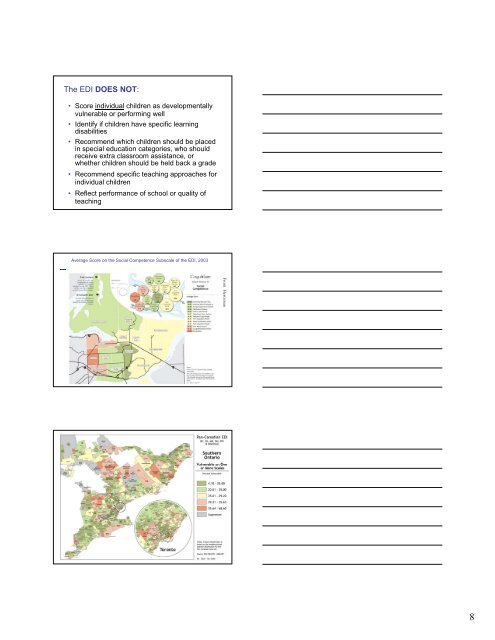Neal Halfon Presentation - Using the EDI for Transforming
Neal Halfon Presentation - Using the EDI for Transforming Neal Halfon Presentation - Using the EDI for Transforming
The EDI DOES NOT: • Score individual children as developmentally vulnerable or performing well • Identify if children have specific learning disabilities • Recommend which children should be placed in special education categories, who should receive extra classroom assistance, or whether children should be held back a grade • Recommend specific teaching approaches for individual children • Reflect performance of school or quality of teaching Average Score on the Social Competence Subscale of the EDI, 2003 From Hertzman 8
2009 snapshot of Australia’s children: a developmental census of five year-olds Northern Territory: 3,255 WA WA: 27,579 27 579 SA: 16,208 Tasmania: 5,916 Queensland: 55,449 NSW: 87,168 ACT: 4,432 Victoria: 61,196 Total = 261,203 children (97.5% of estimated population) 9
- Page 1 and 2: Using the EDI for Transforming Earl
- Page 3 and 4: The existing ECD service system •
- Page 5 and 6: Health Developmeent Creating a 21 s
- Page 7: Early Development Instrument Extens
- Page 12 and 13: Transforming Early Childhood Commun
- Page 14 and 15: Using the EDI to Optimize an Early
- Page 16 and 17: • Each Network member agency or i
- Page 18 and 19: Community Data Dashboard Developmen
- Page 20 and 21: The EDI in Wichita Falls • Implem
- Page 22 and 23: The Institutions Government (HA, CD
- Page 24: Conclusions about the EDI • The E
The <strong>EDI</strong> DOES NOT:<br />
• Score individual children as developmentally<br />
vulnerable or per<strong>for</strong>ming well<br />
• Identify if children have specific learning<br />
disabilities<br />
• Recommend which children should be placed<br />
in special education categories, who should<br />
receive extra classroom assistance, or<br />
whe<strong>the</strong>r children should be held back a grade<br />
• Recommend specific teaching approaches <strong>for</strong><br />
individual children<br />
• Reflect per<strong>for</strong>mance of school or quality of<br />
teaching<br />
Average Score on <strong>the</strong> Social Competence Subscale of <strong>the</strong> <strong>EDI</strong>, 2003<br />
From Hertzman<br />
8



